Trees & Shrubs
Canyon Country Nature GuideLimited by lack of water, the trees and shrubs of the high desert environment of canyon country must disperse in order to survive. As a rule, they grow rather small and far apart. But once established these desert plants are tenacious. Their roots can split rocks in search of nutrients or water, and many can live over 100 years. Some of the more common trees you’ll see are the cottonwood, pinion pine, and juniper. Shrubs that you are likely to see include mormon tea, four-wing saltbush, and cliffrose.
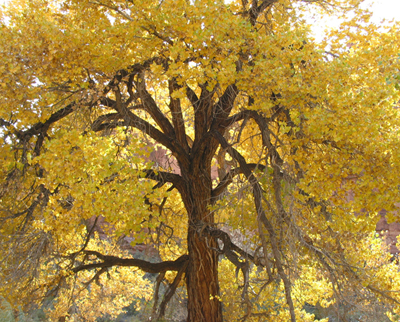
Fremont's Cottonwood
(Populus fremontii)
Cottonwoods are found in riparian corridors where water is plentiful,along streams and washes. This large tree is 33′ to 82.5′ (10 to 25 m) tall. The genus name, “Populus”, is Latin for “people” because the many leaves moving in a breeze resemble a moving populace. The species name, “fremontii”, honors explorer John Charles Fremont (1813-1890).
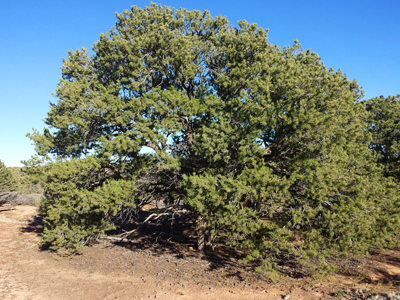
Pinyon Pine
(Pinus edulis)
Pinyons are conifers that have crooked trunks, reddish bark and are very slow growing. Trees 4 to 6 inches (10 to 15 cm) in diameter and 10 feet (3 m) tall may be 80 to 200 years old. This conifer is 16.5′ to 66′ (5 to 20 m) tall. Pinyons produce compact cones that contain tasty, protein-rich seeds called pine nuts. Pine nuts were a major source of food for Native Americans and are still popular today. Animals like the bushy-tailed woodrat, the pinyon mouse and the pinyon jay also prize them.
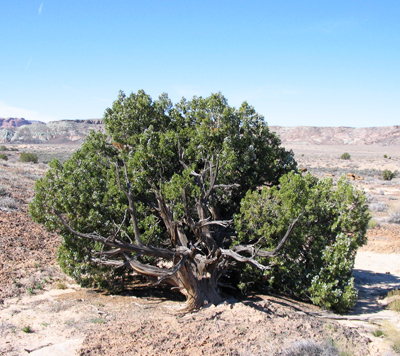
Utah Juniper
(Utah Cedar)
(Juniperus osteosperma)
The Utah juniper is a conifer that is 6.6′ to 13.2′ (2 to 4 m) tall. It is the classic desert tree Its twisting, often-dead branches seem to epitomize the struggle of life with little water. When moisture is scarce, a juniper will actually stop the flow of fluids to some outer branches so that the tree has a better chance for survival. Scale-covered leaves and bluish, waxy-coated seeds help the tree conserve moisture.
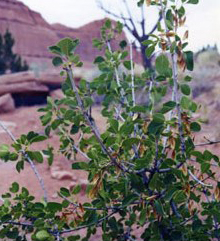
Singleleaf Ash
(Fraxinus anomala)
Singleleaf ash is a deciduous tree that is 8.3′ to 13.2′ (2.5 to 4 m) tall. The genus name, “Fraxinus”, is the classical Latin name for this genus and the species name, “anomala”, means “anomaly” which refers to this unique species of ash that does not have compound leaves. The stout wood was used as digging sticks and tool handles by settlers and Native Americans.
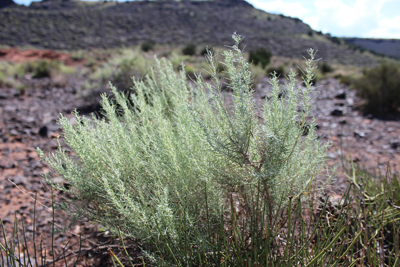
Old Man Sage
(Sand Sage)
(Artemisia filifolia)
Sage is an aromatic shrub that is 1.5′ to 4.9′ (.5 to 1.5 m) tall with silvery leaves. This genus is named for Artemisia, queen of Caria (now Turkey) (ca 400 B.C.), a botanist and scholar. The species name, “filifolia”, means “threadlike leaves”. Sages are rich in oils and resins and are found in every part of the world.
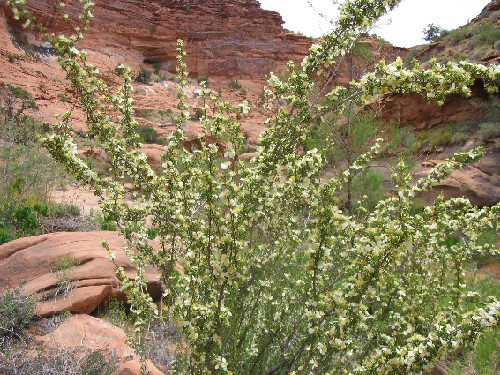
Clifrose
(Quinne Bush)
(Purshia mexicana var. stansburyana)
Cliffrose is a shrub or small tree that is 1.98′ to 11.6′ (0.6 to 3.5 meters) tall. This member of the rose family has sweet-smelling flowers that bloom from April to early November. The genus name, “Purshia”, honors Frederick Traugott Pursh (1774-1820), an author of one of the earliest floras of North America. The species name, “mexicana”, means “of or from Mexico”, referring to the plant’s range.
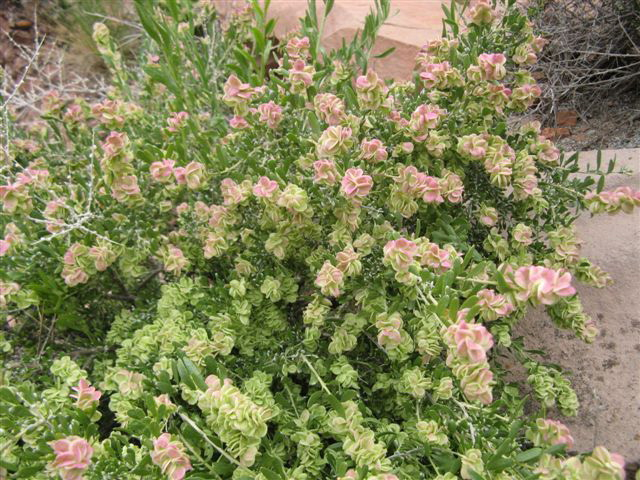
Four-Wing Saltbush
(Atriplex canescens var. occidentalis)
Four-wing saltbush is a woody shrub that is 2.6′ to 6.6′ (.8 to 2 m) tall. This shrub is an important browse plant and the seeds provide food for animals such as antelope and squirrels. The genus name, “Atriplex”, is the Latin name for the plant. The species name, “canescens”, means “grayish-white” and refers to the color of the leaves. This plant’s common name comes from the seed’s appearance and the fact that it typically grows on salty soils.
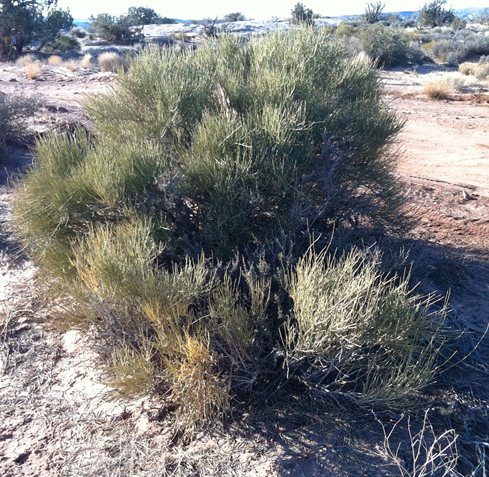
Mormon Tea
(Brigham’s Tea)
(Ephedra viridis var. viridis)
Mormon tea is a shrub that grows to be from 3.9′ to 4.9′ (1.2 to 1.5 m) tall. The genus name, “Ephedra”, is the Greek name for the common mare’s tail plant (Hippuris) which it somewhat resembles. The species name, “viridis”, means “green” and refers to the plant’s overall color. The name of this plant references its medicinal use by early Mormon settlers.
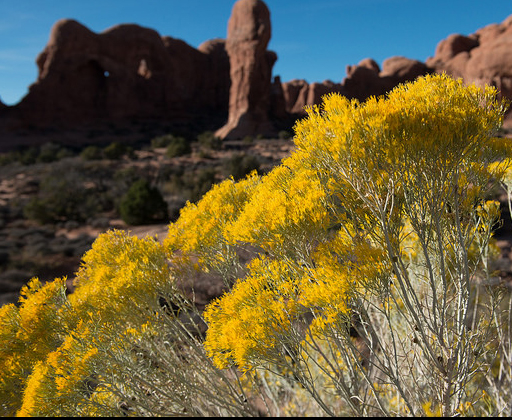
Rabbitbrush
(Chamisa)
(Chrysothamnus nauseosus)
Rabbitbrush is a shrub that is 7.9” to 9.8′ (2.4 to 2.9 m) tall. It dons yellow flowers arranged in flat-topped clusters at the ends of the branches from June to November. The genus name, “Chrysothamnus”, is from the Greek “chrysos” meaning “golden” and “thamos” meaning “a shrub”. The species name, “nauseosus”, means “heavy-scented” referring to the smell of the leaves and the flowers. Native Americans used this plant to make a yellow dye.
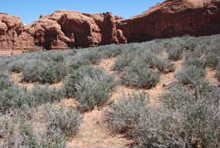
Blackbrush
(Coleogyne ramosissima)
Blackbrush is a small shrub that is 11.8” to 3.9′ (30 cm to 1.2 m) tall. The genus name, Coleogyne, is from the Greek “koleos” which means “sheath” and “gune” which means “ovary”. The species name, “ramosissima”, means “many branched”. many areas are covered in blackbrush, giving the landscape a uniform dark-gray color. Some plants may be very old. Studies of historic photographs show that only 1% of the plants have died in the past 100 years. Animals often burrow under these shrubs. Blackbrush depends on rodents to plant its seeds.
